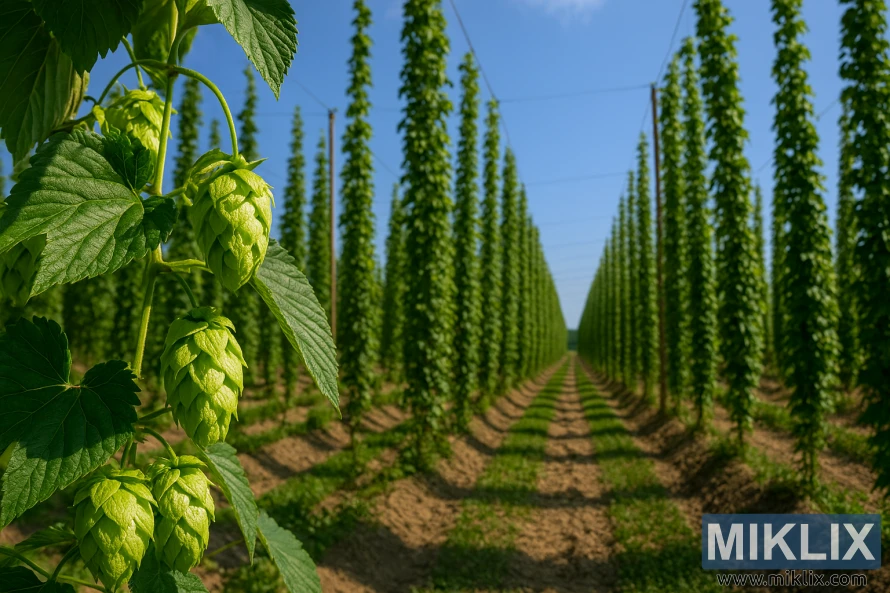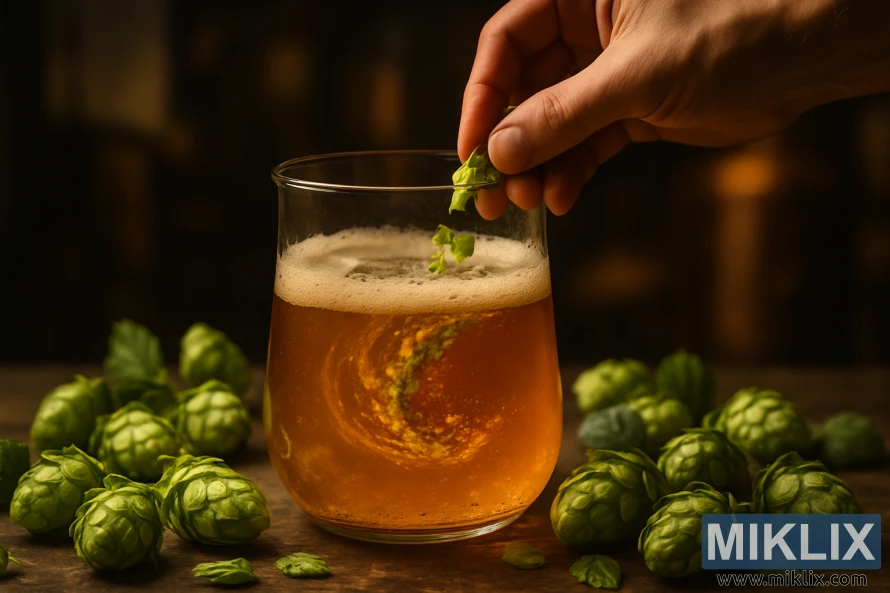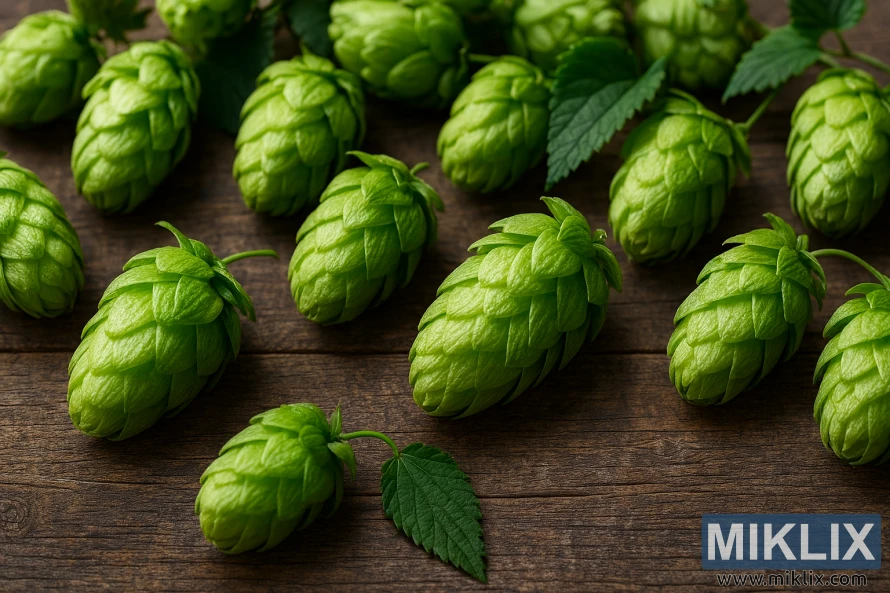Hops in Beer Brewing: Zenith
Published: August 22, 2025 at 9:13:38 AM UTC
Last updated: November 25, 2025 at 10:41:44 AM UTC
Beer brewing is an art that demands precision and the finest ingredients. The selection of high-quality hops is critical in crafting the perfect brew. Zenith Hops, with their unique flavor and aroma, are a favorite among brewers for bittering. These hops add complexity and depth to various beer styles. Grasping the characteristics and uses of Zenith Hops can transform the brewing process. It allows for the creation of unique and flavorful beers.

Key Takeaways
- Zenith Hops are used for bittering in beer brewing.
- They offer a distinctive flavor and aroma profile.
- These hops are versatile and can be used in various beer styles.
- Understanding Zenith Hops can enhance the brewing process.
- They contribute to the complexity and depth of beer.
Introduction to Zenith Hops
Originating from a carefully planned cross at Wye College in the 1970s, Zenith Hops have carved a niche in the world of beer brewing. This cross marked a significant milestone in hop breeding. Zenith Hops are a seedling selection from this cross.
The development of Zenith Hops at Wye College, England, highlights the institution's historical contribution to hop varieties. Their introduction in the brewing industry has sparked interest. This is due to their unique characteristics and their promise in beer production.
Key aspects of Zenith Hops include:
- Their origin from a cross made at Wye College in the 1970s.
- Their role as a seedling selection, indicating a deliberate effort to enhance certain traits.
- Their application in beer brewing, contributing to the diversity of hop varieties used in the industry.
Understanding the history and background of Zenith Hops is essential for appreciating their value in brewing. As the brewing industry continues to evolve, the role of specialized hop varieties like Zenith Hops becomes increasingly significant.
Chemical Composition and Characteristics
Grasping the chemical makeup of Zenith Hops is vital for tapping into their full brewing capabilities. These hops boast an alpha acid content ranging from 9% to 11%. This high alpha acid level is a cornerstone of their bittering prowess, making them a favorite among brewers for adding depth and complexity to their brews.
The bittering prowess of Zenith Hops stems mainly from their alpha acid content. Alpha acids are the culprits behind beer's bitter taste, and Zenith Hops' high concentration makes them exceptionally effective for bittering. This trait enables brewers to hit the desired bitterness levels with fewer hops, which is cost-effective and enhances flavor.
Beyond their alpha acid content, Zenith Hops also contain beta acids, essential oils, and secondary metabolites. These compounds play a role in shaping the beer's flavor and aroma. The synergy between these components and the hops' bittering properties makes Zenith Hops adaptable for a wide range of brewing tasks.
- High alpha acid content (9-11%) for effective bittering
- Presence of beta acids and essential oils contributing to flavor and aroma
- Versatility in brewing applications due to their unique chemical profile
The chemical makeup of Zenith Hops impacts not just their bittering but also their overall contribution to the beer's taste and aroma. By comprehending these characteristics, brewers can more effectively incorporate Zenith Hops into their recipes. This results in a balanced and complex beer that highlights the distinctive qualities of these hops.
Aroma and Flavor Profile of Zenith Hops
Zenith Hops are known for their pleasing bouquet and citrus notes, making them a staple in craft brewing. Their unique aroma and flavor profile are sought after by brewers aiming to enhance their beers' complexity and depth.
The aroma of Zenith Hops is often described as floral and spicy, with a noticeable citrus undertone. This bouquet contributes significantly to the beer's overall sensory experience, making it more appealing to consumers.
In terms of flavor, Zenith Hops are celebrated for their hoppy citrus flavors. These flavors range from subtle orange and lemon notes to more pronounced grapefruit undertones. This versatility allows brewers to experiment with various beer styles, from crisp lagers to complex ales.
The key characteristics of Zenith Hops' flavor profile include:
- Citrus flavors, such as lemon and orange
- Floral notes that add a subtle complexity
- A balanced bitterness that enhances the overall flavor
By incorporating Zenith Hops into their brewing recipes, craft brewers can create a wide range of beer styles. These beers showcase the unique aroma and flavor profile of these hops. Whether used in IPAs, pale ales, or other beer styles, Zenith Hops add a distinctive character that beer enthusiasts will appreciate.
Growing and Harvesting Practices
The art of growing and harvesting Zenith Hops is essential for producing top-notch hops for brewing. This variety, favored by many brewers, demands specific cultivation methods to enhance yield and quality.
Cultivating Zenith Hops involves several critical elements. These include soil quality, climate conditions, and farming techniques. Optimal conditions include well-drained soil and a moderate climate.
Timing is everything when it comes to harvesting Zenith Hops. They are typically ready for harvest in late summer to early fall. This timing varies based on the region and climate.
Here are some key considerations for growing and harvesting Zenith Hops:
- Soil preparation: Ensure the soil is well-drained and rich in organic matter.
- Irrigation management: Balance irrigation to avoid overwatering, which can lead to disease.
- Pest and disease management: Regularly monitor for pests and diseases, and implement integrated pest management strategies.
- Harvesting technique: Use appropriate machinery to minimize damage to the hop cones during harvesting.
For brewers looking to grow their own Zenith Hops, starting small is wise. This allows for testing local growing conditions and refining techniques.

Storage and Preservation Methods
To get the most out of Zenith Hops, brewers must understand the best storage and preservation methods.
Proper storage and preservation are critical for maintaining the quality and flavor of Zenith Hops. If not stored correctly, hops can lose potency and develop off-flavors.
- Store hops in a cool, dry place, away from direct sunlight and heat sources.
- Use airtight containers or packaging to prevent exposure to air and moisture.
- Keep hops away from strong-smelling foods or chemicals, as they can absorb odors easily.
Preservation methods also play a key role in maintaining Zenith Hops quality. Some common techniques include:
- Freezing: Freezing hops can help preserve their alpha acids and essential oils.
- Vacuum Packaging: Removing air from packaging can help prevent oxidation and spoilage.
- Cold Storage: Storing hops in cold environments can slow down degradation processes.
By following these storage and preservation methods, brewers can ensure their Zenith Hops remain fresh and effective. This ultimately results in better-tasting beer.
Brewing Techniques with Zenith Hops
To maximize Zenith Hops, brewers must focus on several critical aspects. These include the timing of hop additions and the chosen brewing method. Known for their strong bittering, Zenith Hops are perfect for adding complexity to beers.
For bittering, adding Zenith Hops early in the boil is key. This allows for full isomerization of alpha acids, boosting the beer's bitterness. The bittering power of Zenith Hops can vary due to crop year and growing conditions. Always check the alpha acid content before adding them to your brew.
Zenith Hops are also suitable for flavor and aroma additions. Adding them later in the boil or during the whirlpool introduces herbal and spicy notes. Dry-hopping with Zenith Hops can further enhance the beer's aroma. Their relatively low aroma compared to other hops might necessitate blending with other varieties.
The brewing method significantly influences Zenith Hops' contribution to the beer. Techniques involving higher temperatures or longer boil times can impact alpha acid extraction and hop oil preservation. Grasping these dynamics is essential for unlocking Zenith Hops' full range in various beer styles.
- Consider the alpha acid content of Zenith Hops when calculating bitterness additions.
- Use Zenith Hops early in the boil for bittering or later for flavor and aroma.
- Experiment with combining Zenith Hops with other hop varieties to create complex flavor profiles.
Ideal Beer Styles for Zenith Hops
Zenith Hops are versatile, used in Pale Ale, Stout, and Lager. Their unique flavor profile suits a variety of brewing needs.
Pale Ale is a favorite for Zenith Hops. The hops' balanced alpha acids and distinct flavor complement the ale's maltiness. This creates a balanced taste. The aroma of Pale Ale brewed with Zenith Hops is enhanced, featuring citrus and floral notes.
Zenith Hops are also used in Stout and Lager. In Stout, they add depth and complexity to the rich, roasted flavors. In Lager, they contribute to a crisp, clean taste. This versatility allows brewers to create unique and delicious brews.
Commercial beers like certain Pale Ales and Lagers from well-known breweries showcase Zenith Hops. These beers highlight how Zenith Hops can elevate flavor and aroma. This makes them a popular choice among brewers.
Hop Scheduling and Timing
Effective hop scheduling is vital for maximizing the flavor and aroma of Zenith Hops in beer brewing. The timing of hop additions significantly impacts the final product's characteristics. Zenith Hops, with their unique profile, require careful consideration to optimize their contribution to the beer.
The brewing process involves several stages where hops can be added. Each stage influences different aspects of the beer's flavor and aroma. Understanding when to add Zenith Hops is key to achieving the desired outcome. The primary stages for hop addition are during the boil, flameout, and dry hopping.
During the boil, hops are added at various times to contribute bitterness, flavor, or aroma. Early additions mainly contribute bitterness, while later additions enhance flavor and aroma. For Zenith Hops, late boil additions are key due to their aromatic properties. Flameout additions, made after the heat source is turned off, allow the hops to steep in the hot wort. This extracts delicate aromas and flavors without adding bitterness.
Dry hopping, which involves adding hops to the beer after fermentation, is a technique used to enhance the beer's aroma without contributing bitterness. Zenith Hops can be used effectively for dry hopping due to their distinct aroma profile. The duration of dry hopping can vary, but it's typically done for a few days to allow the beer's aroma to develop fully.
- Early boil additions for bitterness
- Late boil additions for flavor and aroma
- Flameout additions for enhanced aroma
- Dry hopping for intense aroma
The timing and quantity of Zenith Hops used in these stages depend on the brewer's goals and the specific beer style being brewed. Experimentation with different hop scheduling techniques can help brewers find the optimal balance for their beers.

Comparing Zenith Hops to Other Varieties
The world of hops is vast and varied, making it essential to compare Zenith Hops to others like Northern Brewer. Zenith Hops are renowned for their bittering capabilities. But how do they compare to other popular bittering hops?
Zenith Hops can often be swapped with Northern Brewer and Yeoman hops in recipes. Northern Brewer hops have a slightly different alpha acid profile. This can impact the beer's bitterness and flavor. Yeoman hops, in contrast, offer a strong bittering characteristic, akin to Zenith Hops.
Several factors are at play when comparing these hops. These include alpha acid content, oil content, and the flavor they add to beer. Here's a brief comparison:
- Zenith Hops: Known for their clean bittering and moderate alpha acid content.
- Northern Brewer Hops: Offers a slightly higher alpha acid content and a more traditional bittering flavor.
- Yeoman Hops: Provides a robust bittering with a higher alpha acid content compared to Zenith Hops.
Understanding these differences is key for brewers aiming to create specific flavor profiles. Whether brewing a traditional ale or an IPA, the right hop variety is critical.
In conclusion, while Zenith Hops are a favorite among brewers, comparing them to Northern Brewer and Yeoman hops offers valuable insights. These insights highlight their unique characteristics and uses in various beer styles.
Common Brewing Challenges and Solutions
Zenith Hops, known for their unique characteristics, can pose brewing challenges that require tailored solutions. Achieving a balanced flavor profile is a primary concern when brewing with Zenith Hops. Their distinct aroma and bitterness can overpower other ingredients if not managed correctly.
Several factors can affect the flavor and aroma of beer when using Zenith Hops. Timing of hop additions, quantity used, and brewing technique are key. For instance, adding Zenith Hops too early can result in an overly bitter beer. Adding them too late might not utilize their aromatic properties.
To overcome these challenges, brewers can employ several strategies. Adjusting the hop schedule to optimize the timing of Zenith Hop additions can significantly impact the final product's balance. Experimenting with different quantities of Zenith Hops can help in achieving the desired flavor and aroma profile.
- Inconsistent Flavor Profile: Adjusting the hop schedule and quantity can help achieve consistency.
- Overpowering Aroma: Balancing Zenith Hops with other ingredients and adjusting the brewing technique can mitigate this issue.
- Bitterness Levels: Controlling the timing and amount of Zenith Hops added during brewing can help manage bitterness.
By understanding the common brewing challenges associated with Zenith Hops and implementing the right solutions, brewers can unlock the full potential of these hops. This allows them to create unique, high-quality beers that showcase their distinct characteristics.

Commercial Brewing Applications
Zenith Hops have become essential in commercial brewing for their distinct flavor and aroma. Their adaptability enables brewers to create a broad spectrum of beer styles, from light ales to complex lagers.
In commercial beer production, Zenith Hops significantly influence the final product's taste and smell. The timing of hop addition, boil duration, and dry-hopping methods are critical. For example, adding Zenith Hops in the late boil or dry-hopping stages boosts the beer's aroma. Early additions, on the other hand, contribute more to bitterness.
Many commercial breweries have successfully integrated Zenith Hops into their recipes. Some use them in pale ales to achieve a balanced flavor with citrus and floral hints. Others experiment with them in unique brews, highlighting their versatility.
The widespread adoption of Zenith Hops in commercial brewing is also attributed to their availability and consistent quality. Breweries depend on Zenith Hops for the desired flavor and aroma, making them a reliable choice in the industry.
As the demand for craft and specialty beers escalates, Zenith Hops will likely remain a cornerstone in commercial brewing. They are instrumental in crafting innovative and premium beers.
Recipe Development and Experimentation
Zenith Hops bring a unique twist to craft brewing, making them a versatile ingredient for recipe development. Brewers can use these hops to craft innovative beers that capture the market's attention.
Understanding how Zenith Hops interact with other ingredients is critical when experimenting. Their alpha acid content, flavor profile, and aroma can greatly influence the beer's final taste.
- The timing of hop additions, which impacts the beer's bitterness, flavor, and aroma.
- The proportion of Zenith Hops to other hops and ingredients, shaping the brew's overall character.
- The brewing technique, including mash temperature, boil time, and fermentation conditions, which can enhance or diminish Zenith Hops' characteristics.
Experimentation is essential to achieve the perfect balance. Here are some tips for brewers aiming to innovate with Zenith Hops:
- Begin with small batches to test different hop quantities or timing.
- Keep detailed records of your experiments, including recipes, brewing processes, and tasting notes, to refine your approach over time.
- Feel free to combine Zenith Hops with other hop varieties or ingredients to create something new.
Beer styles like pale ales, IPAs, and certain lagers highlight Zenith Hops' unique qualities. Their crisp, clean flavor and moderate bitterness are ideal for these styles.
By grasping Zenith Hops' characteristics and experimenting with various brewing techniques and recipes, brewers can discover new flavors and aromas. This exploration can redefine the limits of craft brewing.
Conclusion
Zenith Hops stand out for their unique blend of traits, making them a top pick for brewers aiming to craft complex, balanced beers. Their distinct aroma and flavor enhance a wide range of beer styles, from pale ales to IPAs.
This article emphasizes the significance of grasping the chemical makeup, cultivation methods, and brewing techniques of Zenith Hops. By excelling in these areas, brewers can fully harness Zenith Hops' capabilities. This results in exceptional beers that highlight their unique characteristics.
As brewers keep pushing the boundaries with Zenith Hops, the realm of new beer styles expands. Whether you're an experienced brewer or just beginning, Zenith Hops are a compelling choice for your next brewing endeavor.

Further Reading
If you enjoyed this post, you may also like these suggestions:
- Hops in Beer Brewing: Spalter Select
- Hops in Beer Brewing: Blue Northern Brewer
- Hops in Beer Brewing: Ivanhoe
